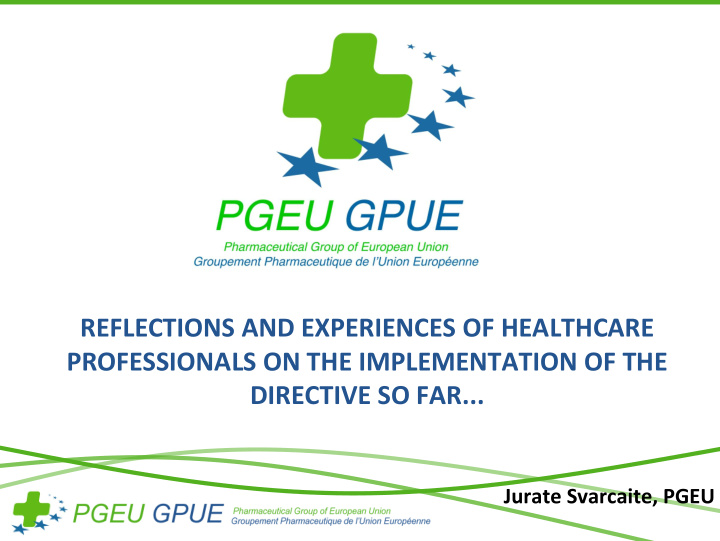



REFLECTIONS AND EXPERIENCES OF HEALTHCARE PROFESSIONALS ON THE IMPLEMENTATION OF THE DIRECTIVE SO FAR... Jurate Svarcaite, PGEU
Pharmaceutical Group of European Union Members: Professional Bodies & Pharmacists ’ Associations Netherlands Austria Poland Belgium Portugal Bulgaria Romania Cyprus Slovakia Czech Rep Slovenia Denmark Spain Estonia Sweden Finland United Kingdom France Croatia Germany FYR Macedonia Greece Norway Hungary Serbia Ireland 2012: 31 Countries Switzerland Italy Turkey Luxembourg Malta
Healthcare Professionals Working Group (HCPWG) The European Medicines Agency/Committee for Medicinal Products for Human Use Working Group with Healthcare Professionals' Organisations is a platform for dialogue and exchange of information with healthcare professionals’ organisations. Three priority areas for its work: information on medicines; pharmacovigilance activities; involvement of healthcare professionals’ organisations in the work of the Agency’s scientific committees.
Expectations Clear tasks and responsibilities for all Member States, EMA, industry. Improved decision-making procedures at the Community level and efficient use of resources in the network. Proactive and proportionate risk management. Stronger link between safety assessments and regulatory action. Strengthened transparency, healthcare professionals involvement.
Key points of the Directive for HCPs (I) New medicines and specific products subjected to additional monitoring will need to be identified trough a black symbol in the summary of products characteristics (SMPC) and patient information leaflet(PIL). Patient direct reporting is enabled. EU and MSs will need to set up linked pharmacovigilance websites . Those websites will include assessment reports, summaries of product characteristics and patient information leaflets. Eudravigilance database becomes the single point of receipt of pharmacovigilance information for medicinal products authorised in the EU. MSs may impose specific obligations for healthcare professionals in the reporting system.
Key points of the Directive for HCPs (II) HCPOs may be involved in the consultation regarding the tasks assigned to HCPs in the pharmacovigilance system. HCPOs will need to be consulted in the future eventual revision on the PIL and SmPC content. New scientific committee at the EMA: “the Pharmacovigilance Risk Advisory Committee” („PRAC‟) responsible for providing advice on pharmacovigilance will have a representative of healthcare professionals. Competent authorities may grant exceptions to the labelling and packaging requirements in cases of severe problems in respect of the availability of the medicinal product.
REFLECTIONS AND EXPERIENCE SO FAR…
Communication by the Agency 5 th Stakeholder Forums took place since in 2011- 2012, 3 HCPWG meetings, 2 joint meetings with PCWP, Regular updates by e-mails and in a form of press releases. Overall communication by the Agency is outstanding
Involvement of HCPs Numerous presentations by HCPs during Pharmacovigilance Stakeholder Forum’s, Consultation on Good Vigilance Practice (GVP) modules, Consultation on the Eudrovigilance data presentation, Usability testing of the EMA adverse drug reaction website, Consultation on the design of web-reporting forms for Healthcare professional reporting of adverse drug reactions, Consultation on black symbol and accompanying test, Etc.
Some reflections… ‘’ Some HCPOs are more involved than others in the implementation of the directive. Pharmacists are on the frontline , while nurses are more focusing on consequences of the implementation in their clinical activities. The requests for comments from the Agency were then not adapted for some HCPOs .’’ ( ESNO ) ‘’ From now on there is a long way and hard work to do to disseminate the information and to implement the knowledge and the applicability of the new legislation for professionals (Task of the PRACC, when, how, what type, ethical issues about the clinical trials that will be required or not post-authorization). In this context there is a strong need of join workshop within EMA and specific HCPOs (in my cases, specifically the European Society of Cardiology) in order to understand the future practicalities of the legislation .’’ ( ESC )
National reflections… ‘’In Finland the EMA has been quite invisible, but the national (medicines agency) FIMEA has keenly worked according to the EMA and directive mainstream…’’ ( CPME )
PGEU EXPERIENCE
Communication Regular updates to Members during face to face meetings of dedicated working groups and General Assemblies, Written updates in the monthly reports of the Secretariat, Work Programme, Annual report, Dedicated sessions during Annual Symposium, E-mail communication.
Participation in Consultations Consultation on the Eudrovigilance data presentation, Usability testing of the EMA adverse drug reaction website, Consultation on the design of web-reporting forms for Healthcare professional reporting of adverse drug reactions, Consultation on black symbol and accompanying test, Etc.
Expectations of Pharmacists 17/06/2011 Cases like Mediator to be detected earlier using Eudravigilance! ‘Dear health professional’ instead of ‘Dear doctor’ letter. To be consulted in the future eventual revision on the PIL and SmPC content. Instant overview of medicines safety issues when using public interface of Eudravigilance. Feed back Individual follow up of reports + safety info feed into pharmacy ICT support tools.
Outstanding issues Improve spontaneous ADRs reporting by pharmacists, Participation in awareness campaigns on black symbol and additional monitoring, ‘Pharmacovigilance: more a responsibility Promote Eudrovigilance database among practitioners, than a role!’ Feed latest safety information into pharmacy ICT support Kelly B. Pharmacovigilance: more a responsibility than a role. Austr Pharm 2001;20:128. tools, Involvement in the risk assessment of pharmacy practitioners, Medicine shortages.
THANK YOU www.pgeu.eu
Recommend
More recommend